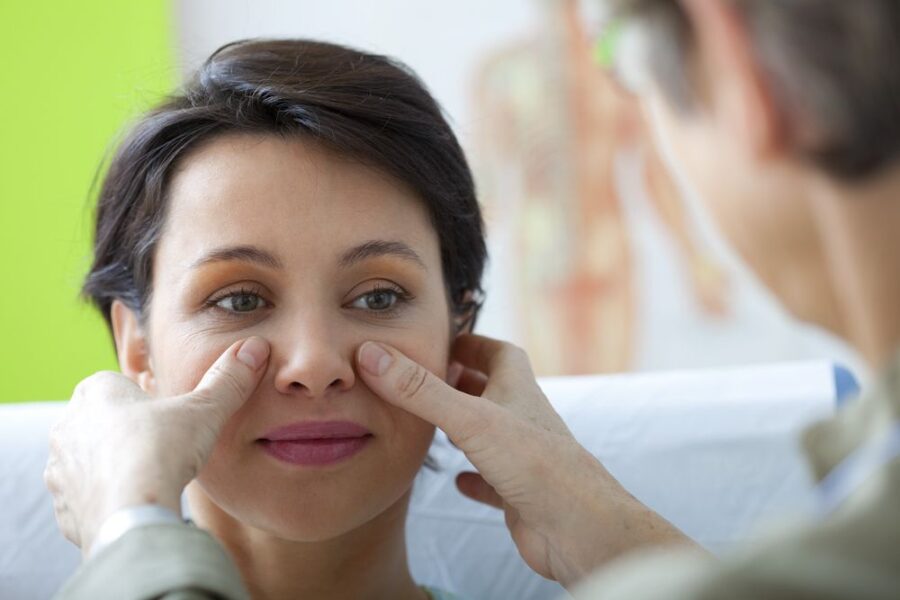You may have been looking for a surprising solution to relieve your aching molars, and yoga for teeth pain may be it. Imagine the benefits of gentle stretches and breathing exercises that not only benefit your body but also your dental health. It’s like a calm voyage for your teeth. We’re getting into the specifics of how yoga can become your new dental health friend in this blog. We’re investigating the all-encompassing method of treating tooth pain, which includes reducing jaw tension and encouraging relaxation throughout your mouth. Now spread out your mat, get into a pose, and let’s all say goodbye to those annoying toothaches!
Link Between Yoga and Dental Health
Connection Between Stress and Teeth Pain
Stress and dental pain frequently coexist, creating a vicious cycle that can make dental problems worse. Our bodies create stress-related hormones like cortisol, which can impair immunity and cause inflammation all over the body, including the gums. An increased level of stress can physically manifest as clenching or grinding of the teeth, and it can even worsen pre-existing dental issues like gum disease and cavities. In order to treat the underlying causes of tooth pain and maintain long-term dental health, it is essential to comprehend this connection.

How Yoga Alleviates Stress and Improves Dental Well-being
Yoga is a great way to relieve stress because it provides a variety of benefits for oral health. Yoga counteracts the negative effects of stress on the mind and body by combining physical postures, breathing exercises, and meditation techniques to activate the body’s relaxation response. Regular yoga practice can help people feel less stressed overall, ease tension in their jaw and other face muscles, and encourage serenity and relaxation. These advantages go beyond simple stress relief because they also immediately enhance dental health by addressing the root causes of tooth pain and discomfort.
Importance of Holistic Approaches in Dentistry
The significance of holistic dentistry techniques—those that take into account the connection between the body, mind, and spirit in fostering general dental health—has come to light in recent years. Holistic dentistry addresses the underlying imbalances—such as poor diet, stress, and systemic inflammation—that lead to oral problems rather than just treating the symptoms. This strategy is in perfect harmony with yoga’s emphasis on holistic well-being, which provides a whole arsenal for fostering oral health from the inside out.
Science Behind Yoga for Teeth Pain
Research-backed Evidence Supporting Yoga for Dental Health
Many research have emphasized the advantages of yoga for dental health, offering strong proof of its effectiveness in reducing tooth pain and enhancing general oral health. Studies that have been published in credible scientific journals have shown that frequent yoga practitioners report less dental problems such jaw discomfort, gum inflammation, and tooth sensitivity.
Furthermore, yoga therapies have been demonstrated in controlled clinical trials to improve a number of oral health indices, such as saliva production, gum health, and oral bacterial count. These results highlight yoga’s therapeutic potential as an adjunct to conventional dental care, providing patients with a holistic and all-natural way to manage dental problems and maintain good oral hygiene.
Impact of Yoga on Inflammation and Oral Health
A major underlying cause of many dental issues, such as periodontitis, gingivitis, and tooth discomfort, is inflammation. Research indicates that doing yoga regularly can result in considerable reductions in systemic inflammation indicators including C-reactive protein (CRP) and interleukin-6 (IL-6). Yoga has been shown to have a remarkable effect on inflammation levels in the body.

It helps to improve dental health by reducing inflammation, which lowers the risk of gum disease and other inflammatory disorders that aggravate tooth discomfort. Furthermore, by encouraging stress reduction and strengthening immune function, yoga’s emphasis on deep breathing and relaxation techniques can further reduce inflammation and strengthen the body’s defenses against dental infections and preserve ideal oral health.
Dr. Chamria’s Insights on Integrating Yoga into Dental Care
Leading dentist and proponent of holistic dentistry Dr. Chirag Chamria stresses the value of incorporating yoga into dental care regimens to treat the underlying causes of tooth pain and enhance long-term oral health. Dr. Chamria claims that yoga is a priceless supplement to conventional dental treatments because it provides a special set of tools for controlling stress, inflammation, and other variables that lead to dental disorders.
Patients who incorporate yoga into their daily routines can develop habits that promote general well-being and resilience against future dental disorders, in addition to receiving immediate relief from the symptoms of tooth pain. To guarantee that each patient gets the most out of an all-encompassing approach to dental care, Dr. Chamria suggests customized yoga regimens.
Key Yoga Poses for Teeth Pain Relief
Downward Dog Breath
One of the fundamental yoga poses, downward dog, is well-known for its many health advantages, including better blood circulation. This version incorporates concentrated breathing techniques to boost gum health, increase oxygen flow to the gums, and reduce inflammation.
This stance helps the gums regenerate and mend by increasing blood flow to the area. Moreover, improved circulation facilitates the elimination of toxins, reducing the risk of gum disease and its associated discomfort.
Child’s Pose
A gentle yoga pose that’s great for unwinding and relieving tension is called child’s pose. The temporomandibular joint problems and bruxism that might arise from jaw strain and tooth pain are primarily caused by stress.
People who consistently perform Child’s Pose can promote relaxation and reduce dental discomfort brought on by clenching their jaws under stress. In addition to lowering stress levels and supporting general oral wellness, this stance also promotes deep breathing.
Cobra Pose
The backbend stance known as “Cobra Pose” strengthens the arms, shoulders, and back muscles while also improving oral health. Cobra Pose, when done carefully, utilizes the jaw muscles, strengthening and enhancing their resistance.
A stronger jaw helps lessen the chance of toothaches and jaw pain by supporting the teeth and surrounding structures more effectively. Moreover, Cobra Pose has the ability to increase salivation, which is beneficial for oral hygiene and gum and tooth disease prevention.
Meditation and Deep Breathing
Through the mind-body link, meditation and deep breathing exercises are essential parts of yoga practice and have significant advantages for dental wellbeing. Dental issues like tooth discomfort, gum disease, and oral infections are significantly influenced by stress. Stress reduction through meditation contributes to better oral health overall.
Diaphragmatic breathing is one of the deep breathing techniques that promotes relaxation and lowers oral cavity inflammation by increasing oxygen supply to the body and brain. Deep breathing exercises and meditation can help people develop a state of peace and well-being that improves their dental health by lessening the frequency and intensity of tooth pain episodes.
Yoga Practices for Daily Dental Care Routine
Developing a Customised Yoga Routine for Optimal Oral Health
Developing a customized yoga practice based on your unique dental requirements can greatly improve your mouth health. By using breathing exercises and yoga poses, you can promote relaxation and reduce discomfort. It focuses on the areas of stress on the face, neck, and jaw. Adopting postures that improve circulation and stimulate salivary flow can help maintain a healthy oral environment and prevent dental problems.

Incorporating Mindfulness into Tooth Brushing and Flossing
Your everyday dental hygiene regimen can become more thoughtful by incorporating mindfulness practices into it. It can become less of a tedious activity. Practice your brushing and flossing motions to ensure thorough cleaning and reduce the risk of gum disease and plaque buildup. Reducing stress-related dental problems like teeth grinding and jaw clenching, mindful tooth brushing and flossing also encourage calm.
Dr. Chamria’s Recommended Yoga Techniques for Dental Hygiene
For better dental hygiene, Dr. Chirag Chamria suggests adding certain specific yoga poses to your regular routine. These can include breathing techniques to encourage relaxation and salivation, mild jaw stretches to release tension, and mindfulness exercises to develop awareness when brushing and flossing. You may maintain a healthy smile for many years by making the most of your dental hygiene efforts. By making these yoga positions a regular part of your routine.
Yoga Lifestyle Habits for Stronger Teeth
Dietary Guidelines to Support Dental Health
Strong teeth and gums depend on eating a nutritious, well-balanced diet. Include foods strong in calcium, such almonds, dairy, and leafy greens, to help strengthen and remineralize enamel. Incorporate foods high in vitamin C, such as bell peppers and citrus fruits, to help collagen synthesis and gum health. Eat less acidic and sugary foods as these might exacerbate tooth erosion and decay.
Role of Hydration in Preventing Teeth Pain
Maintaining dental health and avoiding tooth pain need drinking enough of water. Plaque development and cavities can be prevented by drinking enough water throughout the day to wash away food particles and bacteria from the mouth. Additionally, drinking more water causes saliva to produce more, which helps shield tooth enamel from acids. As acidic and sugary drinks can exacerbate dental issues, make an effort to stay hydrated by drinking lots of water.
Sleep and its Impact on Overall Dental Well-being
Getting enough sleep is essential for maintaining general oral health. The body regenerates and repairs tissues as you sleep, including the tissues in your mouth. Lack of sleep or poor quality sleep might impair immunity and make mouth infections and inflammation more likely. Dental problems including gum disease and enamel degradation can also be attributed to sleep disruptions like teeth grinding or sleep apnea.
Conclusion
With its dual focus on oral health (physical and emotional), yoga offers numerous benefits when it comes to treating tooth pain holistically. People can reduce stress, ease tooth discomfort, and improve their general well-being by adding yoga into their regular dental care practices. Recognizing yoga’s ability to supplement conventional therapies and foster long-term dental wellness, Dr. Chirag Chamria is an advocate for this integrative approach. Adopting yoga for dental health allows for stronger teeth, better gums, and a more joyful smile by promoting a harmonious mind-body connection. Unlock the door to radiant dental health by discovering the transformative potential of yoga for treating tooth pain.






